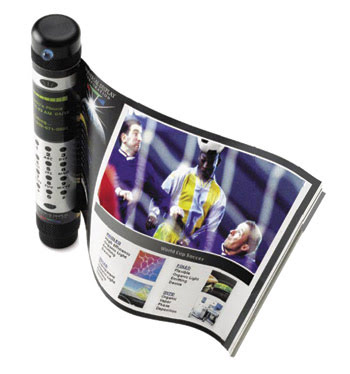US Display Consortium focuses on transformational technology initiatives.
Mark Hartney, US Display Consortium
Nearly 15 years ago, the US Display Consortium was established as a public-private partnership to bring together manufacturers and suppliers, universities, display integrators and the government. Its goal was to define and implement projects to jump-start the US display industry. These plans included research and development as well as the generation of market information and technology road maps to benefit the industry. The consortium, based in San Jose, Calif., has since initiated more than 130 development projects, resulting in a number of important manufacturing tools and novel materials in widespread use today.
The group continues to focus on new display technologies by conducting studies on 3-D displays, on organic light-emitting diodes (OLEDs) and on high-resolution imaging. However, the main focus is on two initiatives: flexible displays built on plastic or metal foils rather than on rigid glass or silicon wafers; and organic electronics — devices that feature polymeric or small-molecule compounds with innovative conducting or insulating properties.

OLED technology lends itself to flexible substrates. Courtesy of Universal Display Corp.
OLED displays offer lower cost and lower power consumption than conventional active-matrix LCD technology, as well as improved color performance. They will be used in flexible displays, including those that can be integrated into clothing, as well as on conformal surfaces, such as cockpit windows, and on roll-up displays. The OLED market is approaching $1 billion annually in display applications, primarily thanks to the technology’s integration into mobile phones and MP3 players.
A new opportunity
Flexible electronics technology is a transformation from the traditional rigid substrate with high resolution and a small form factor. Flexible electronics are accomplished through merging new, large-area electronic platforms with traditional materials and industries, such as textiles, building materials and plastics. This industry will require new materials, processes and technology, as well as innovative large-area system design. Flexible electronics can incorporate much of the developments in other fields, such as nanotech/microelectromechanical systems, biosensors, photovoltaics and displays.
The diversity of applications and technologies will be immense because the electronics can tie in with so many markets, including microelectronics and consumer items. They can be used, for example, in chameleon clothing that can camouflage its appearance to match its environment. Flexible electronics also can be used in smart medication devices that administer drugs based on biofeedback and that provide wireless updates to medical care providers.
In microelectronics, costs per function have decreased over 30 years by more than a million times, largely because smaller units are being produced. Human-scale products, however, such as clothes, bandages and solar cells, are necessarily much larger and, going forward, will contain critical elements. First, the materials must be inexpensive — unlike the highly refined crystals used in semiconductor manufacturing. Therefore, a major opportunity exists to develop high-performance, noncrystalline, organic-based materials, especially for electronic/optoelectronic devices.
Second, patterning the materials, which is the major cost of integrated circuit manufacturing, must be made less expensive. For example, integrated circuits cost ~$100,000/m2. Flat panel manufacturing costs are under $10,000/m2, but even this is too expensive for applications such as intelligent clothes. A full-color advertising catalog, which has patterned ink layers on a scale almost smaller than we can see, costs only pennies per square meter. Thus, printing technology as a means of patterning shows great promise. Finally, products for people must bend, flex, conform and be rugged.
Early examples of this manufacturing transition already exist. Some flat panel displays are being manufactured on flexible metal or on plastic substrates that enable their integration into clothing and personal accessories. Many solar cells are built today on metal foils, taking advantage of the lower manufacturing costs of roll-to-roll processing. These are just a few examples of the products that can be created with today’s tools and processes and as more focus is applied to the manufacturing and materials challenges, the sophistication and capability of large-scale electronics will grow at an astounding rate.
The US Display Consortium is organizing the Flexible, Printed and Organic Electronics Initiative, which recommends the formation of a public-private partnership to coordinate research and infrastructure development and to provide communications and collaboration across the wide variety of industries that will be affected by this new paradigm shift. The partnership to foster the development of technology will include participants from government, industry and academe. Its goals are to identify dual-use applications and to coordinate technology and product road maps; to sponsor supply-chain development through precompetitive research and development focused on materials, tooling and processes; and to ensure the availability of human resources and investment capital.
Meet the author
Mark Hartney is chief technical officer of the US Display Consortium, San Jose, Calif.; e-mail: [email protected].